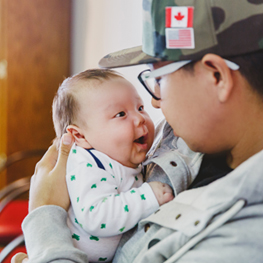
Have you heard of ‘serve-and-return’ interactions and wondered what they are? They are back-and-forth interactions between you and your child - much like a game of tennis or volleyball, where the goal is to keep the ball in the air.
Here’s how it works when your baby is little: they coo, lock eyes with you or cry. This is their ‘serve.’ You ‘return their serve’ by smiling, talking gently, and returning their gaze. This interaction continues until your baby shows you they are done by turning away for a rest. It starts over when they show you that they are ready.
Relationships form through the everyday connections we make with other people
Responding positively to these serve-and-return interactions is one of the most important things you can do with a child because you are responding to their cues and actions. Responding positively lets your child know they are loved and cared for, they are important to you, and helps them learn to trust and relate to others.
Positive serve-and-return interactions with you and other people help to build and strengthen the brain cell connections your child needs to learn new skills in all areas of their development.
Here are some more examples by age group:
Examples of Serve-and-Return Interaction
Your baby serves when they:
Your toddler serves when they:
Your preschooler serves when they:
Your young child serves when they:
You return their serve when you:
You return their serve when you:
You return their serve when you:
You return their serve when you:
Serve-and-return interactions don’t only happen when your child is a baby. Although you may not know it, you’re probably having many serve-and-return interactions with your child every day, no matter how old they are. For example, your preschooler showing you a flower from the garden is a serve. You return the serve as you explore the flower with them and ask questions about it. Or your child serves by telling you about a problem; when you acknowledge their feelings and work with them to think about possible solutions, you’re returning their serve.
As your child gets older, serve-and-return interactions change. The ways that you and other people in your child’s life continue to respond will help them build healthy relationships now and in the future. Take some time to think about the different serve-and-return interactions you have with your child every day.
Enjoy the different serve-and-return interactions you have with your child every day and remember to keep the ball in the air!
This information contains excerpts from Alberta Health Services’ Healthy Parents, Healthy Children print and online resources. For more information on serve-and-return and other topics related to pregnancy and being a parent, and for information on where you can pick up print copies of the Healthy Parents, Healthy Children resources, free of charge, go to healthyparentshealthychildren.ca.
The Healthy Parents, Healthy Children team is a part of the larger Healthy Children and Families’ team at Alberta Health Services. Find them on Facebook at Healthy Parents, Healthy Children or follow on Twitter @AHS_HPHC. For questions or comments, contact This email address is being protected from spambots. You need JavaScript enabled to view it..
Calgary’s Child Magazine © 2024 Calgary’s Child